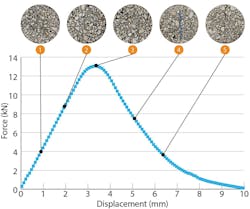Ideal candidate
Nationwide, all state departments of transportation (DOTs) have long dealt with the problem of asphalt cracking, which is the primary type of distress that creates the need for pavement rehabilitation.
With a focus in recent years on making asphalt mixes more affordable, the use of recycled materials and binder modifications has grown, thus increasing complaints that these mixes are even more susceptible to cracking. Many cracking tests have been developed in the past, but no single test is simple, practical, repeatable, and adequately performance-related. For a long time now, there has been a real need for a practical cracking test to be used routinely in the process of asphalt mix design, quality control (QC) and quality assurance (QA) testing.
Recently, the Texas A&M Transportation Institute (TTI) developed and validated an Indirect Tension Asphalt Cracking Test (IDEAL-CT) under NCHRP IDEA Project 195. Thorough lab and field testing presents strong evidence that the test meets standards set in NCHRP 9-57, which has identified seven desirable features for an ideal cracking test:
- Simplicity: No instrumentation, cutting, gluing, drilling, or notching to specimen;
- Practicality: Minimum training needed for routine operation;
- Efficiency: Test completion within one minute;
- Test equipment: Cost less than $10,000;
- Repeatability: Coefficient of variation (COV) less than 25%;
- Sensitivity: Sensitive to asphalt mix composition (aggregates, binder, etc.); and
- Correlation to field performance: Good correlation with field cracking.
The IDEAL-CT is now ready for the next phase of expanded lab and field testing. It is available to contractors, DOTs, and even researchers in academia to routinely use in mix designs and QC/QA. This article highlights a basic description of the test and how it was developed and validated.
What the test covers
The IDEAL-CT is similar to the traditional indirect tensile strength test, and it is run at room temperature with cylindrical specimens at a loading rate of 50 mm/minute. Any size of cylindrical specimens with various diameters (100 or 150 mm) and thicknesses (38, 50, 62, 75 mm, etc.) can be tested. For mix design and laboratory QC/QA in this study, researchers used the same size specimen as the Hamburg wheel tracking test: 150 mm diameter and 62 mm height with 7±0.5% air voids, since agencies are familiar with molding such specimens. Either lab-molded cylindrical specimens or field cores can be directly tested with no need for instrumentation, gluing, cutting, notching, coring or any other preparation. Below is a typical IDEAL-CT: cylindrical specimen, test fixture, test temperature, loading rate, and the measured load vs. displacement curve.
How is the test performed?
- Mold three to five of these cylindrical specimens in a Superpave gyratory compactor with target air voids of 7±0.5%. Prior to compaction, loose mix is short-term aged in an oven for four hours at 135ºC;
- Condition the specimens for a certain time (i.e., two hours) at testing temperature (such as 25ºC);
- To run the test, enter necessary specimen information and place and align the specimen in the loading frame. Then load the specimen at a constant deformation rate of 50 mm/minute until fracture failure occurs; and
- The software provided with the IDEAL-CT system continuously records the load and vertical deformation and automatically calculates the Cracking Test Index or CT-index. The larger the CT-index, the better the cracking resistance.
Because the test does not require additional cutting, notching, drilling, gluing, and further instrumentation, the IDEAL-CT automatically meets the top two desirable features: simplicity and practicality. With the loading rate at 50 mm/minute, and the test time within one minute, the need for efficiency is met. Additionally, the same indirect tensile strength test equipment with a displacement measurement or any other loading frame (such as MTS, UTM or Interlaken) can be used for the IDEAL-CT. Most contractors and DOTs already have such equipment. Even if a new test machine is purchased, the cost is often less than $10,000, making equipment costs very economical. Evaluation and validation of the IDEAL-CT sensitivity, repeatability and correlation to field performance through CTIndex is summarized in the following sections.
A typical IDEAL-CT showing the specimen samples and measured load vs. displacement curve.
Showing sensitivity
A useful cracking test for mix design and QC/QA must be sensitive to the characteristics and volumetric properties of asphalt mixtures and aging conditions. Several variables were evaluated in NCHRP IDEA 195: RAP and RAS content, asphalt binder type, binder content and aging conditions.
A series of laboratory-mixed and laboratory-molded specimens were used to evaluate the sensitivities of RAP and RAS content, binder type and binder content, which are much easier to control in the laboratory than the field plant. A plant mix collected from one field test section in Laredo, Texas, was used for testing sensitivity of aging conditions.
Sensitivity to RAP and RAS
The CT-Index values show that the IDEAL-CT is sensitive to the addition of RAP and RAS to asphalt mixes. The additions of RAP and RAS reduce cracking resistance of the asphalt mix.
Sensitivity to asphalt binder type
The 20% RAP mix with the PG 64-22 binder was further modified with two other virgin binders, PG 64-28 and PG 64-34, to check the sensitivity of the IDEAL-CT to binder type. CT-Index values were tested for each binder type. As expected, the 20% mix with PG 64-34 binder has the largest CT-Index value, followed by the one with PG 64-28 and then the one with PG 64-22. Thus, the IDEAL-CT is sensitive to asphalt binder type.
Sensitivity to asphalt binder content
Asphalt binder content is one of the key parameters for asphalt mix designs and has significant influence on asphalt mix cracking performance. Generally, the higher the binder content, the better the cracking performance in the field. To evaluate the sensitivity of the IDEAL-CT to binder content, the control mix was modified through varying asphalt content only, ±0.5%. It was expected that this mix with +0.5% asphalt binder would have the largest CTIndex value, followed by the control mix, and the one with -0.5% having the least CT-Index value. As expected, the higher the binder content, the larger CTIndex value. Thus, the IDEAL-CT is sensitive to binder content.
Sensitivity to aging conditions
Aging makes the mixes brittle and have less cracking resistance. To be a valid cracking test, the IDEAL-CT must be sensitive to aging conditions of asphalt mixes. In this study, three levels of oven conditioning at 135°C (4, 12 and 24 hours before compaction) were investigated with a plant mix collected from one field test section. As expected, the longer the aging time in the oven, the poorer the cracking resistance. Thus, the IDEAL-CT is sensitive to aging conditions.
In summary, the IDEAL-CT results clearly indicate that the IDEAL-CT is sensitive to key asphalt mix components: RAP and RAS, asphalt binder type, binder content, and aging conditions. Additionally, the COV of the three replicates for each sensitivity evaluation is less than 25%.
Working in the field
Field validation is a crucial step in the process of developing the IDEAL-CT because for any test to be used for mix design, it must have good correlation with field performance. To evaluate this correlation, the study used the accelerated pavement testing data from the Federal Highway Administration’s accelerated loading facility, the full-scale test road in Minnesota (MnROAD), and multiple Texas in-service roads.
All test results indicate that the IDEAL-CT has good correlations with field fatigue cracking, reflective cracking and thermal cracking. With the confidence of the IDEAL-CT in differentiating mix-cracking resistance, researchers took another step toward standardizing the IDEAL-CT through ruggedness testing.
Asphalt cracking, such as the lateral cracking shown here, is a persistent headache for departments of transportation; the IDEAL-CT test could offer help.
Rugged enough
The main purpose of performing ruggedness testing was to identify the factors that significantly influence the cracking resistance measurement of the IDEAL-CT and to estimate how closely these factors need to be controlled. The project team followed the ASTM E 1169-14: Standard Practice for Conducting Ruggedness Tests.
Based on the statistical analysis results, the IDEAL-CT can be considered as rugged with regard to specimen thickness (±2 mm), loading rate (±1 mm/minute), and test temperature (±1°C). The variable of air voids (±0.5%) is identified as a statistically significant variable, but it is not practical to further limit the range of the air voids of the specimens. Thus, the IDEAL-CT, after combining both statistical and practical views, is considered to be rugged with all four variables tested in this study: specimen thickness, loading rate, test temperature and air voids.
Still under evaluation
Both laboratory evaluation and field validation performed during the study were limited. Additional independent mixes, field data, varied traffic load spectrums, different environmental conditions, and different materials (mix types) are required for further evaluation and validation of the IDEAL-CT. Also, researchers recommend an inter-laboratory study to define the precision and bias of the IDEAL-CT. Additionally, CTIndex criteria for different types of mixes should be developed for mix design and QC/QA.
Currently, several DOTs (Texas, New Jersey, Missouri and Minnesota) are evaluating this test for potential adoption.


